White varieties of astilba

White astilbe is considered the most beautiful flower, which is often used when decorating summer cottages. With the help of astilba, you can originally fill both dark corners of the garden, and supplement the flower beds, giving them a special look. All varieties of this plant are undemanding to care for, so they can be easily grown even by novice gardeners.
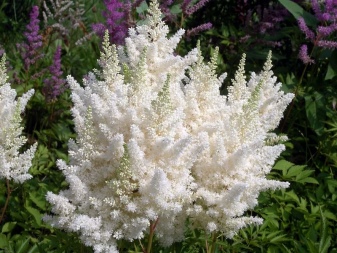
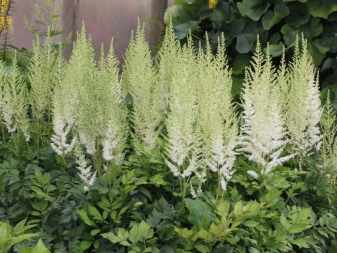
Description
White astilbe belongs to the genus of perennial plants, East Asia is considered its homeland. Today, these amazing flowers grow successfully in Russia, Japan, North America and many other European countries. The height of astilbe can be different, it varies from 10 to 200 cm.Dwarf astilbe grows up to 30 cm, undersized - up to 50 cm, and high up to 2 m.In addition, depending on the shape of the inflorescence, the plants are divided into paniculate (they have branches go up from the main trunk and shorten to the apex), pyramidal (the trunk processes are placed perpendicularly), drooping (due to flexibility and length, the processes tilt to the ground) and diamond-shaped, which are named after the shape of the inflorescences.
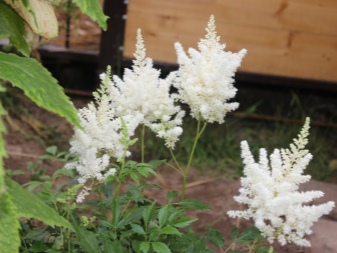

This type of ornamental plant is characterized by a lush flowering that can be enjoyed almost all summer. The flowers of the white astilbe are small in size, they gather in inflorescences that look like panicles. This shrub is best grown in the garden, under the trees, as it prefers shade. In the wild, astilbe can be found along the banks of water bodies, swampy places and deciduous forests.
It is resistant to frost, so it does not require shelter for the winter.
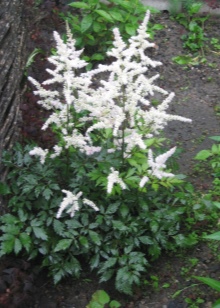
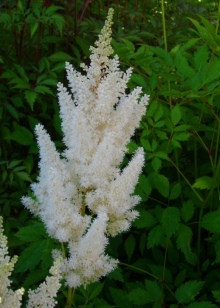
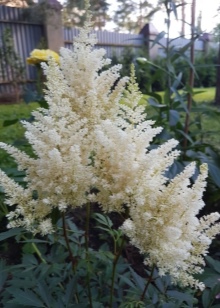
Popular varieties
Today, many varieties of white astilba can be seen on sale, with each variety differing in its characteristics and care requirements. The most common varieties of this ornamental shrub include the following.
- "Unique white". This is a new variety that was bred by breeders in Holland, its main difference is considered to be dense flowering, persistent aroma and compactness. The flowering of this astilba is long, since it begins in mid-summer. "Unique White" looks good in landscape design, where you need to create a light background. It is recommended to plant this variety in shaded areas, since its leaves can curl due to exposure to direct sunlight. You can not plant a plant in a dense shade, this threatens that its flowering will be too weak.
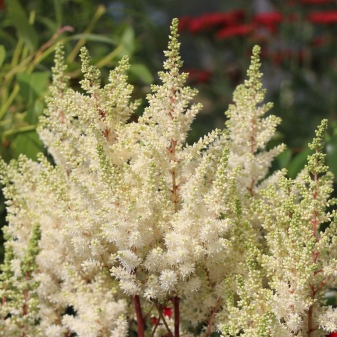
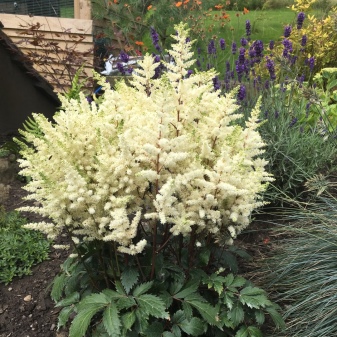
- Visions in White. It is a variety of amazing beauty, it is characterized by milky white dense inflorescences that look gorgeous against the background of dark green foliage with a bronze tint. This hybrid Astilba does well in ambient light. It is ideal for both group and single plantings on lawns, rockeries and mixborders. This variety prefers to grow on loam. The plant, unlike other varieties, begins to bloom later, but during this period it pleases the eye with lush inflorescences of a snow-white shade.


- White Berry. This is a perennial ornamental plant with a powerful root system, in which the ground part dies off for the winter. The stems of "White Berry" are erect, the leaf is carved, shiny, painted in a dark green shade. The shrub usually grows in height and width up to 50 cm. The flowering period of the plant is in July, it lasts about a month.At the end of flowering, fruits appear on the inflorescences (boxes with seeds), which ripen in the first half of September.
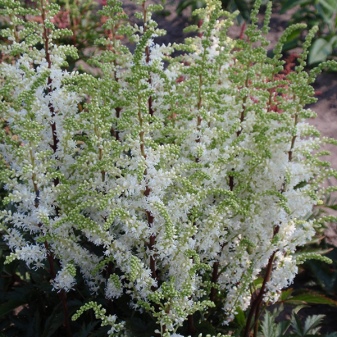
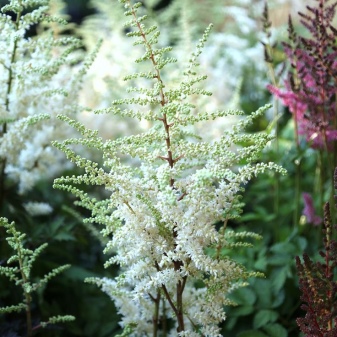
- "White Senseishen". This variety is ideal for landscaping gardens and can be planted with other large shrubs. Single astilbe looks elegant among coniferous plantations. White Sensei's leaves are undivided, shiny with a bright green color. From July to August, snow-white flowers bloom on the bushes, which gather in pyramidal panicles. Astilba of this variety can grow up to 50 cm in height.
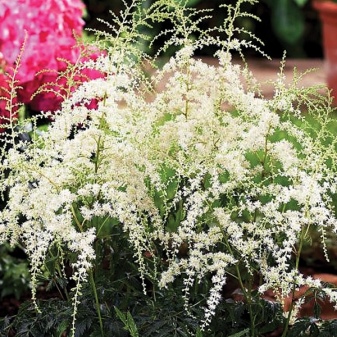

- "Bella". The plant blooms with apical inflorescences, which consist of white openwork star flowers. With proper care, the flowering period of the plant begins in June and lasts until August. The flower is characterized by unpretentious care and frost resistance.
Suitable for growing near bodies of water and densely planted shrubs.
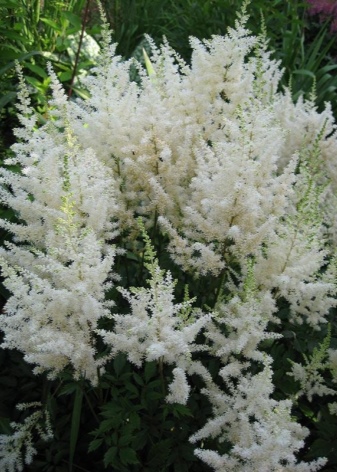
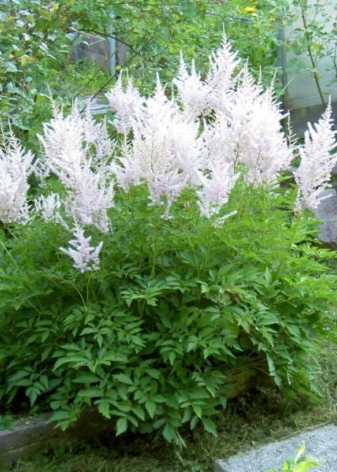
- Deutschland. This variety is great for growing in the Moscow region, since the plant is resistant to cold weather and does not require winter shelter. An adult bush reaches a height of 60 cm. It is covered with dark green shiny foliage, over which a cap of snow-white flowers blooms during flowering. Experienced gardeners recommend growing the plant in the shade, as it fades quickly in the sun. To create a beautiful hedge from this astilbe in landscape design, it is important to follow the planting technique correctly, leaving a distance of 30 cm between the bushes.

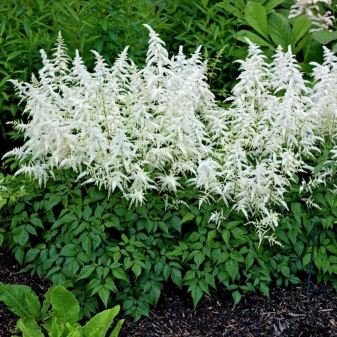
Among the popular varieties of white astilba, one can single out those that do not have a purely snow-white shade, but an admixture of white with pinkish, beige and yellowish. Well-proven varieties include Japanese astilba Avalanche, Deutschland, Snowdrift, Diamant and Weisse Gloria. To this can also be added the distinguished Professor Vander Wielen.
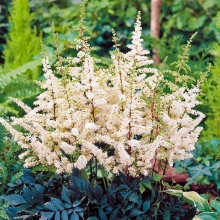
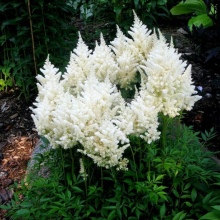
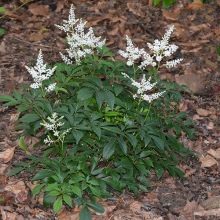
Planting and leaving
White astilba should be planted outdoors, giving preference to areas with moist soil and thin shade. It is not recommended to plant bushes in a sunny place, because due to the large amount of light, the flower can quickly fade, its foliage will quickly turn yellow at the edges. In addition, it will have to be watered often and to protect it from drying out of the soil, cover its top layer with bark, straw and pebbles. Before you start planting astilba, you need to carefully prepare the landing site, namely: dig up the ground, remove all debris, weeds and fertilize well.
Planting flowers is usually carried out from the end of March to the beginning of May, you can also plant plants in the fall, but in this case, the time must be calculated in such a way that the plant has time to get stronger before the cold weather. The depth of the planting pit can be different, it is determined individually for each astilbe, taking into account the size of the roots. The root system should be placed freely in the hole so as not to deepen the bush too much; it is recommended to put a hydrogel on the bottom of the hole. It will keep the soil moist.
After planting, the plant should be watered abundantly, and the surface around the pit should be mulched with peat chips or dry bark.
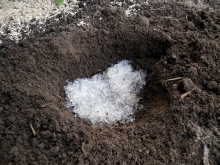

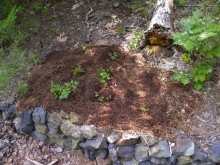
After planting, the plant should be well looked after, providing it with regular watering, fertilization and timely pruning. In addition, in the areas where astilba is grown, soil mulching is additionally carried out. In order for a flower to grow quickly and please with lush flowering, it must receive a complex of trace elements. Fertilizers are recommended to be applied 3 times in the period from May to August: the first top dressing should consist of liquid fertilizers that simulate plant growth, the second is performed during flowering (organic and mineral dressings are well suited), in autumn the bushes are sprinkled with a layer of ash to ensure better flowering on next year.
To maintain the decorative appearance, astilbe should be periodically trimmed. This procedure takes place in several stages: the first time the bush is cut off after flowering (it is cleaned of dried inflorescences), the second - in late autumn or spring before new shoots appear. Despite the fact that white astilba is a perennial plant, its ground part dies off closer to the onset of winter, so it also needs to be cut off.
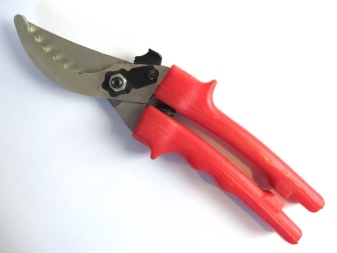
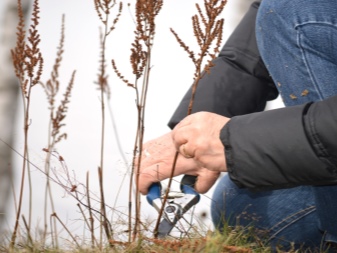
All varieties of white astilba can grow without transplant for no more than 10 years. In order for the bush to bloom well every year and be lush, it is recommended to transplant at least once every 3-4 years (terry astilba is especially demanding for this). This is necessary, since the rhizome of the plant grows, there is little space for it, so it appears above the surface of the earth and is exposed to the negative effects of cold weather in winter and sun in summer.
It is best to transplant the bushes in early spring or autumn, for this they are dug up and divided into separate parts. The transplant is very simple: the planting hole is preliminarily prepared, it is filled with mineral fertilizers, the plant itself is watered abundantly and planted. To fill the voids between the ground and the root, it is necessary to compact the soil, after a few days the bush will successfully take root and begin to grow.
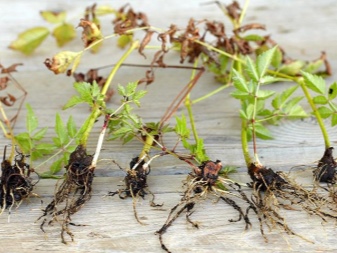
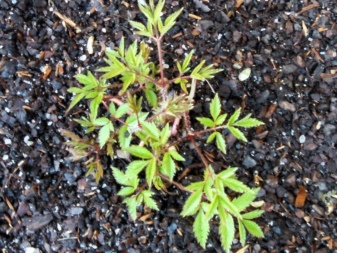
Reproduction methods
White astilba can reproduce in several ways. Some gardeners prefer to pre-sow it in a container, and then plant the already obtained seedlings in open ground. The only thing is that with this method of reproduction, the plant can lose its decorative qualities.
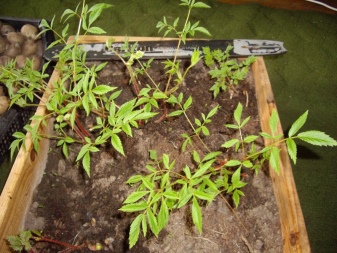
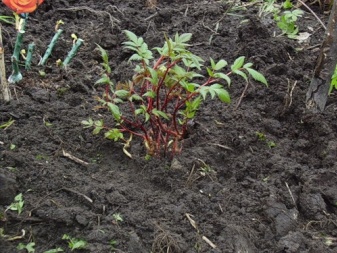
It is much easier to propagate a flower by budding, this is considered the easiest and fastest way.
To do this, in the spring, you need to cut off shoots from young bushes with a small part of the root, sprinkle the cut with ash (for healing). They are planted on a site fertilized with peat, and transplanted in the fall. In addition, astilba can also be propagated by dividing the bush. To do this, you should divide it into several identical parts, each of which should have 3-5 buds. The leaves are trimmed, and the seedlings are planted in a permanent place, watering abundantly every day until rooting.
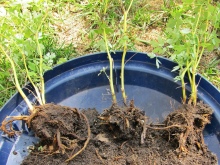

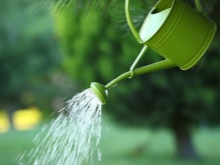
For information on how to care for astilba, see the next video.







































































































The comment was sent successfully.